
6-7 October 2015. We’d been walking for about twenty minutes: from the town of Wadi Musa, through the entrance gates, and for about a kilometre in a wide valley along a broad gravel thoroughfare known as Bab as-Siq. Horses walked or cantered with pounding hooves on a track beside us as far as the entrance to the ravine known simply as the Siq.
Marking the entrance, carved into the sandstone cliffs, are the first of many monumental tombs left by the Nabataeans: the Obelisk Tomb, and below it Bab el-Siq Triclinium, a funerary dining hall where banquets were held in honour of a god or ancestor. The whole structure seems to be a sentinel, and a foreshadowing of what’s to come.
The Siq, meaning shaft, is a shadowy narrow chasm, a natural geographic fault, a deep crack in the land caused by an earthquake and later worn smooth by wind and water. It is a little over one kilometre (3/4 mi) long and in some places no more than two metres (6 ft) wide. The rock walls of this unassailable crevasse are up to 182 metres (600 ft) high.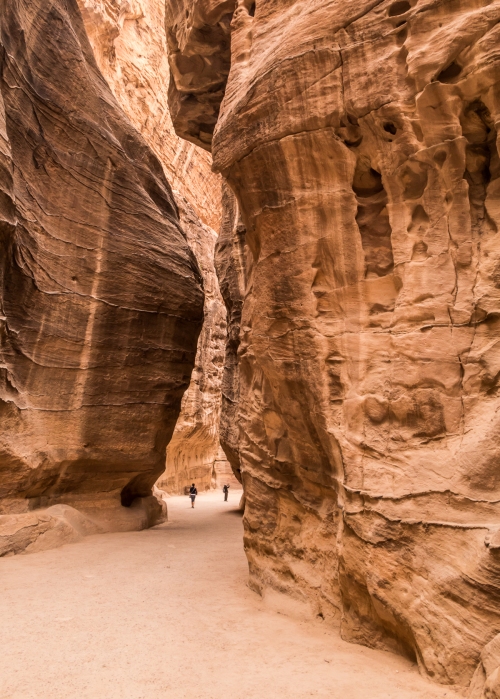
We’ve waited a long time for this and finally we have arrived. We walk through the canyon, the rock walls reaching up on either side dwarfing us. It’s broad at times, allowing sunlight to enter the depths. Occasionally there is a tree, but mainly it is so narrow, and the rock walls so dominant and high that they seem to suck up all heat and light. We are in a dim deep cool silent place. Even though there are many people walking along, snapping pictures, staring, chatting, and we ourselves are part of a group of nineteen people, these rock walls still speak of power and permanence and majesty. They will not be denied.
We walk as a straggly group led by our guide. Suddenly he tells us to stop. He knows the exact spot. On his instructions we take one more step forward and there it is. Suddenly it feels as if doves are exploding into flight in my heart. In front of me is the iconic view of the Treasury at Petra as first seen from the Siq. A sliver of something eternal and enigmatic, classical lines framed by the softly curving rock walls of the canyon. Not a photograph, the real thing there before me. It is a thrilling moment.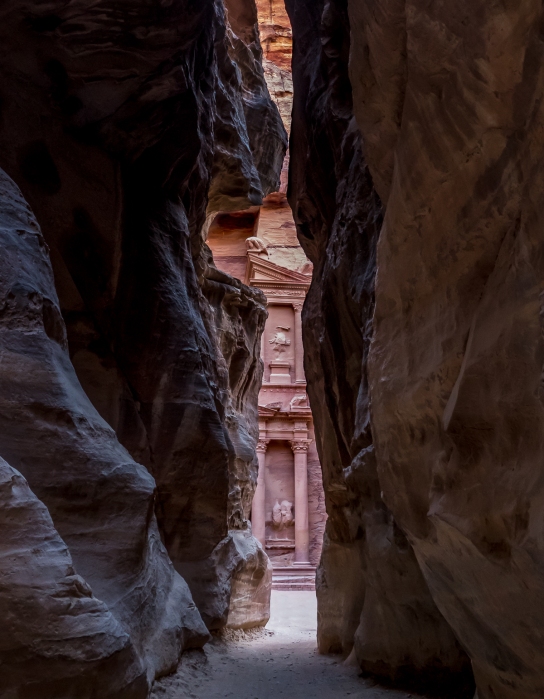
We continue walking. I wonder if we will ever get to the end. And then we are there, stepping out into a broad opening. The Treasury, Al Khazneh, standing before us with its clean Hellenistic lines is like an epiphany, and surely the most spectacular and astounding sight in all of Jordan. It is unsurprisingly Jordan’s most visited tourist attraction.
The Treasury, carved directly from the rock, was the tomb of King Aretas III, and displays the extraordinary engineering skills of the Nabataeans. There was a legend that bandits, or pirates, or an Egyptian Pharaoh fleeing the Israelites, hid their treasure in the urn above the central pediment, hence the colloquial name, but no treasure has ever been found despite local Bedouins over the centuries taking potshots at the urn in an attempt to dislodge it. The urn has been proven to be solid stone.
The Nabataeans were an industrious Arab people who settled in the area more than two and a half thousand years ago. Petra, their capital, was known to the Nabataeans as Raqmu. It was a natural fortress, and by figuring out how to control the water flowing through the wadi, often in the form of flash floods, they established an artificial oasis. In doing so they also established control of the main commercial routes that passed through the area. Petra became the centre of the Nabataean caravan trade. The Siq was the grand caravan entrance.
The Nabataeans flourished for about five hundred years until around 100 AD when they were absorbed into the Roman Empire. Petra continued as an important trading centre under the Romans.
Apparently the Romans never left:
From the Treasury we again enter a narrow opening in the rock walls that opens into a long, broad valley with red-orange cliffs rising up on either side.

We have entered a magical world of camels, donkeys and horses, and their Bedouin caretakers. If you wanted to you could travel around all of Petra on the back of one of these animals.
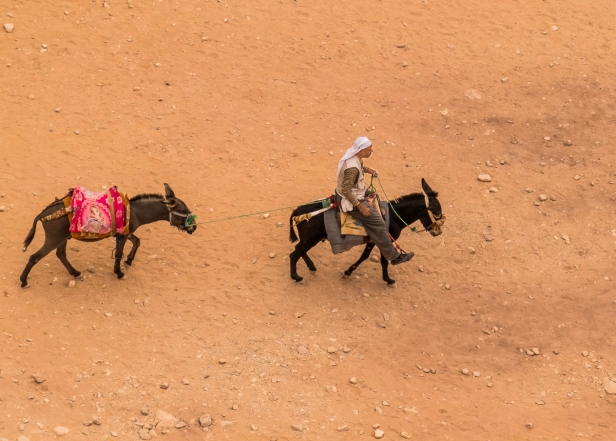

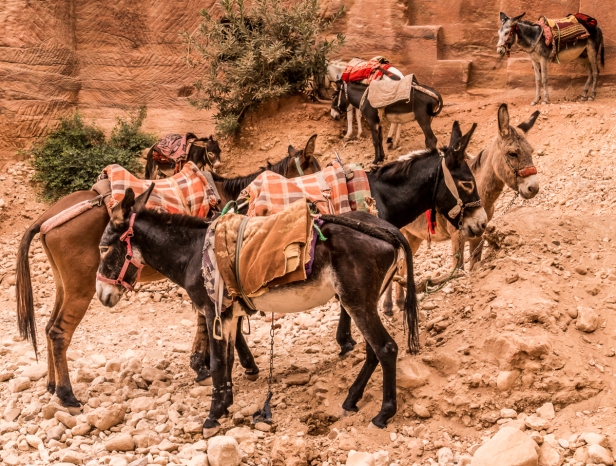
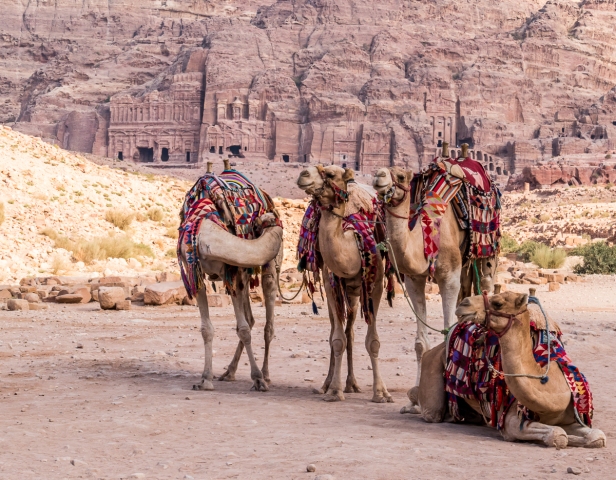
Or like us you could walk. We walk all day covering twenty kilometres (13 mi). Petra is vast.
We follow the valley past hundreds of elaborate tombs carved into the cliffs. The houses of the Nabataeans were destroyed by earthquakes, but the tombs were built to last for eternity. Five hundred have survived.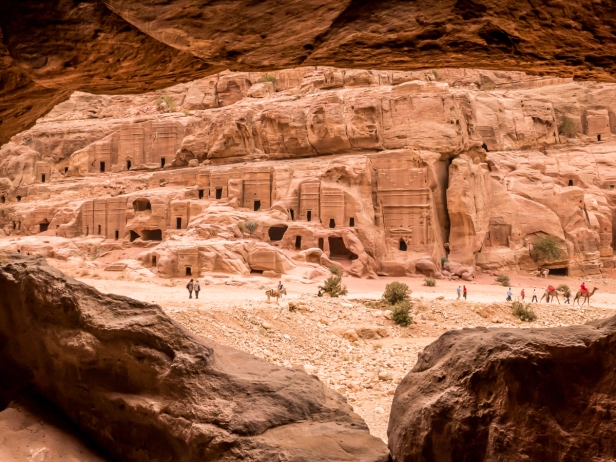

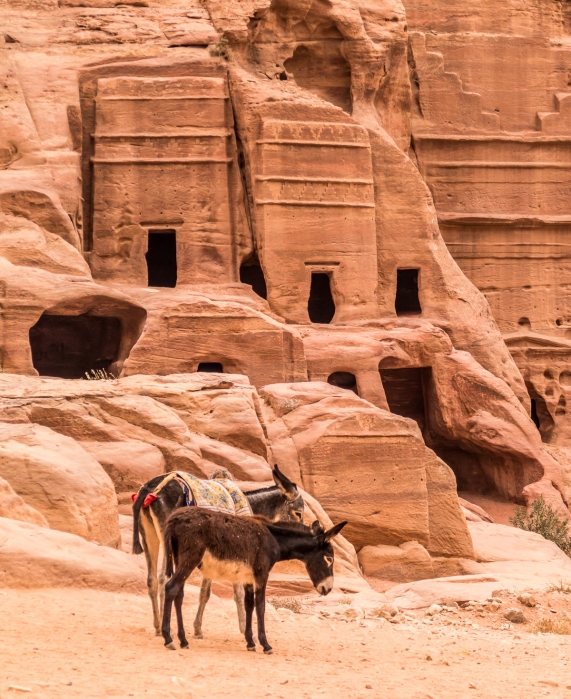
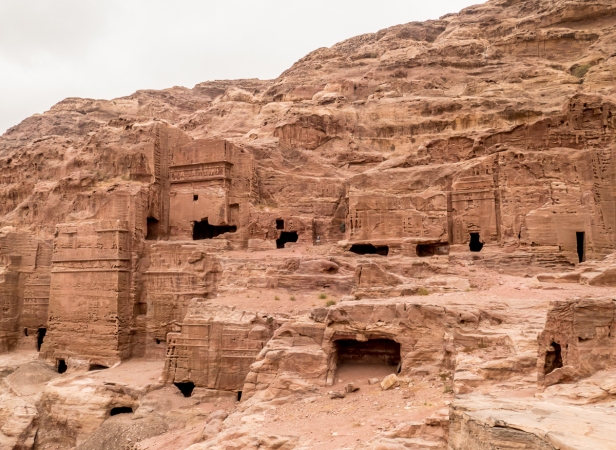

The entrance to one of the royal tombs:
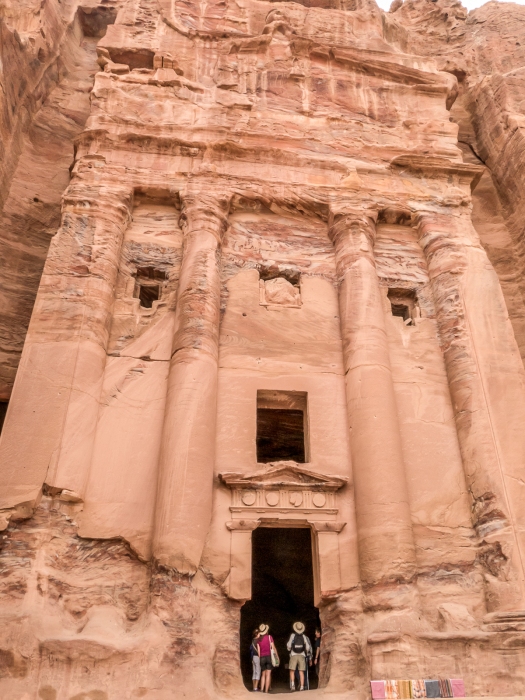
There are obelisks, sacrificial altars, colonnaded streets, a theatre, and temples. I am awed by the sheer size, the geometric perfection, and the elegant classical lines.
There is an ageless rock-cut path of more than eight hundred steps, the processional route to The High Place of Sacrifice of this ancient civilization.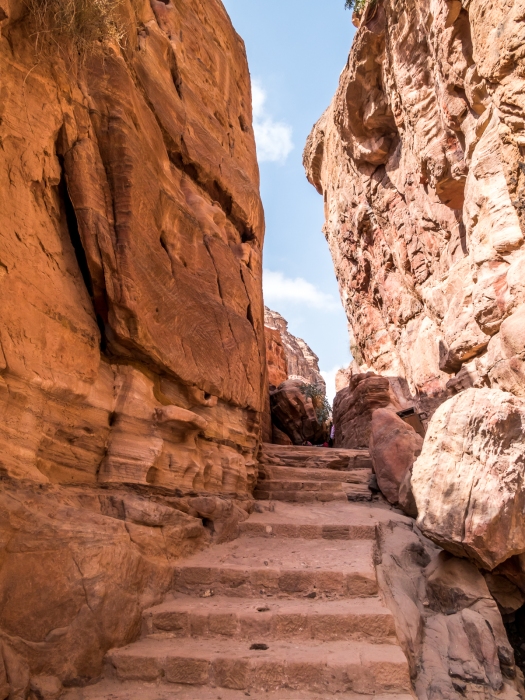
It leads high up in the hills where the views are glorious,

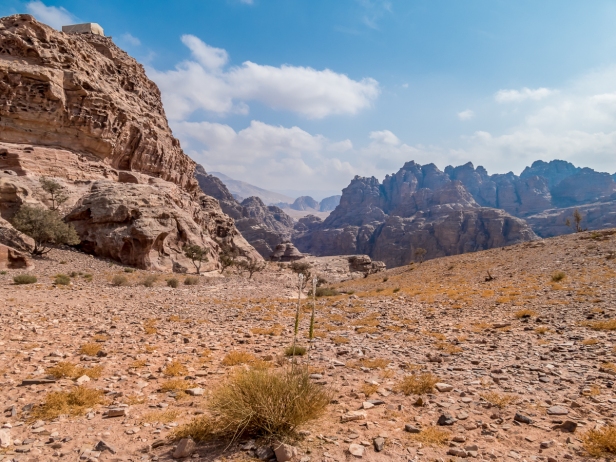
and where the Ad-Deir Monastery is hidden away. It is one of the great monuments of Petra, another grand Nabataean tomb, similar in design to the treasury but much bigger. It is 50 metres (164 ft) wide and 45 metres high (147 ft), built in perfection more than two thousand years ago.
At the end of the day after twenty kilometres I am exhausted and in pain. But I don’t care. I didn’t want to miss anything, and anyway what’s a bit of pain when the rewards are so great? I take some over-the-counter medication; better living through chemistry. The next morning we set out again. Our guide leads us on a hike through the backcountry high above the ancient city.
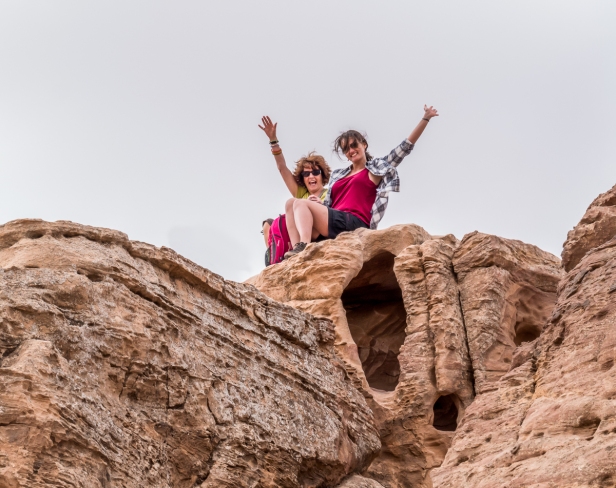
There’s nothing like a pathway; we are clambering over boulders; dropping a few feet to a lower elevation then climbing up again; more boulders; creeping along a narrow ledge with a sheer drop down one side, an overhang on the other, and a climb down and then up again at the end.

Through it all we follow our guide. And then on a high plateau he tells us to stop. Once again he knows the exact spot. We turn around and there it is. For the second time in two days I disintegrate with joy into a million sparkling fragments. I am dazzled. We are above the Treasury, looking down upon it.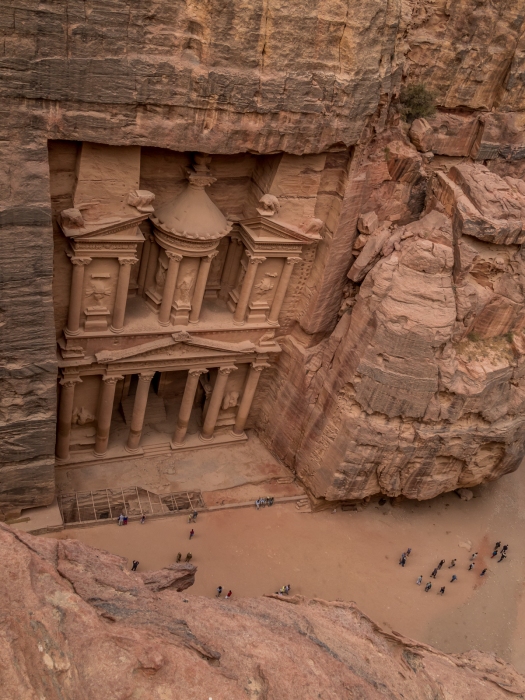

We are also above the Roman theatre,
and the tombs of Petra. 
Climbing down a thousand stone steps worn smooth and grooved by a million footsteps over hundreds of years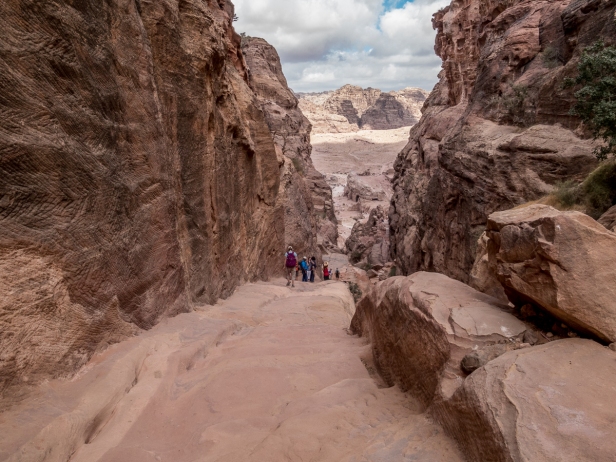
we run into Ross and Tanya. We’d had dinner with them at the mysterious menagerie in Amman a week ago. Of all the places we, or they, could be in Jordan, we reconnect on the stone steps of Petra. After chatting a while we join our group for a feast in a Bedouin restaurant back down in the valley,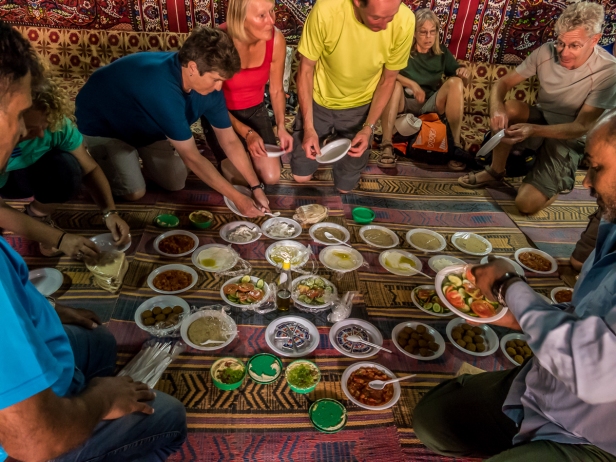
and then straggle back to our hotel. The horse and carriage drivers do good business at the end of the day when many are too tired to walk the two kilometres (1.25mi) back to the town.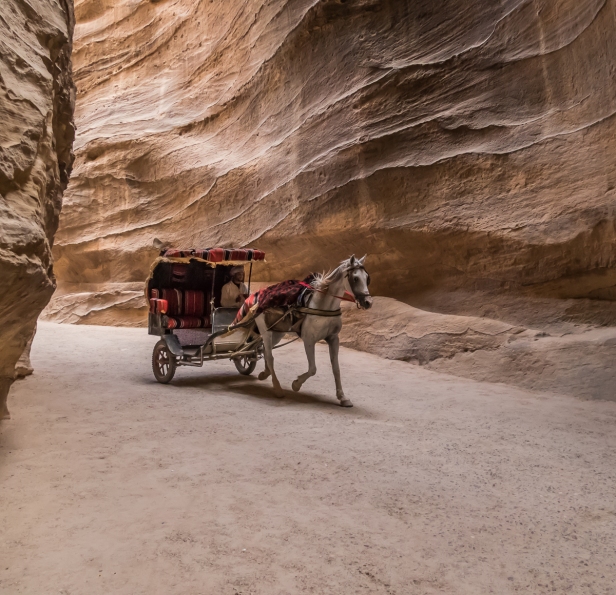
After dinner we go to a hammam, an experience both startling and wonderful – dripping from every pore in a hot steam room, then emerging to a cooler steamy room and suddenly I’m deluged in icy cold water, screaming with laughter, then lying on a marble slab with legs in the air while more cold water rains down on me, then being scrubbed all over, a massage in a separate room, and finally a shower. I feel well-scrubbed, well-watered, and completely enervated in a good way.
After the exhaustion of two days of hiking all over, and the hammam experience, I am deliciously drained. Petra by Night is a tourist thing that gets mixed reviews. Candles light the length of the Siq, and there is tea and traditional music in front of the Treasury, also lit by candles. From online photographs it looks beautiful, but I can’t face walking another 4 kilometres there and back, there is only one other person in our group who expresses any interest in going, and our guide is not enthusiastic about it. We decide not to go.
UNESCO has described Petra as “one of the most precious cultural properties of man’s cultural heritage”. In 2007 it was included as one of the New Seven Wonders of the World, and it was chosen by Smithsonian Magazine as one of the “28 Places to See Before You Die”. All of these accolades are well deserved. Petra has its own special mysterious magic, and you can’t help but fall under its spell.
In 1845 John Burgon, an Anglican clergyman, won the Newdigate Prize for his poem Petra, a city which he had never seen.
It seems no work of Man’s creative hand,
by labour wrought as wavering fancy planned;
But from the rock as if by magic grown,
eternal, silent, beautiful, alone!
Not virgin-white like that old Doric shrine,
where erst Athena held her rites divine;
Not saintly-grey, like many a minster fane,
that crowns the hill and consecrates the plain;
But rose-red as if the blush of dawn,
that first beheld them were not yet withdrawn;
The hues of youth upon a brow of woe,
which Man deemed old two thousand years ago,
match me such marvel save in Eastern clime,
a rose-red city half as old as time.
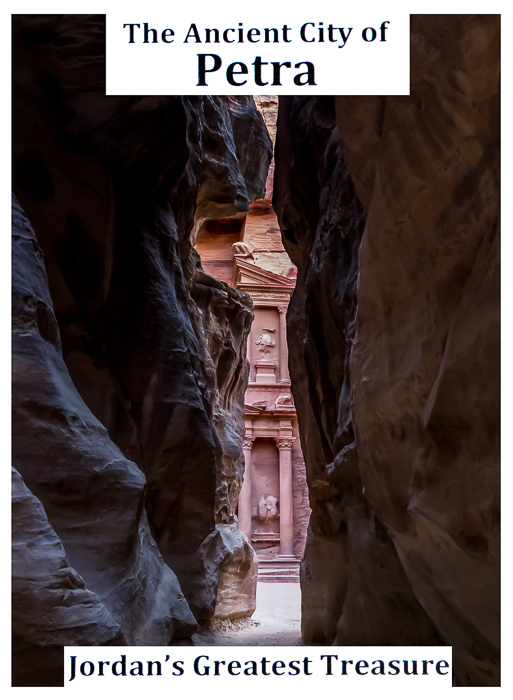
Next post: Little Petra (yes there’s more from these extraordinary people), and the Bedouins of Jordan.
All words and images by Alison Louise Armstrong unless otherwise noted
© Alison Louise Armstrong and Adventures in Wonderland – a pilgrimage of the heart, 2010-2016.

I am still fascinated how those buildings were carved out of the rock. I am sorry we never got to Petra when we were in Egypt but through your blog I could experience it to a degree.
LikeLiked by 1 person
I too am fascinated by how they built them. I saw a video a long time ago that demonstrated it – from a hazy memory I think they were built from the top down. Maybe you’ll get to Jordan one day, but I’m glad you got a good feel of it from my post.
Alison
LikeLike
Alison, your writing and photographs gave me goosebumps. I definitely want to experience Petra. What an experience you had. And the poem….
LikeLiked by 1 person
Wow, thank you so much Alison. I’m so glad you enjoyed it. Petra was definitely a huge highlight.
Yes, such a brilliant poem: “from the rock as if by magic grown”. And: “But rose-red as if the blush of dawn, that first beheld them were not yet withdrawn”.
It’s astonishing that Burgon had never been there.
Alison
LikeLike
Thanks for taking me back to Petra! It was so much bigger than we expected and the buildings kept getting fascinating the further in we went. One day really was not enough. We would definitely want to go back to Jordon one day.
LikeLiked by 1 person
My pleasure! I’m glad you enjoyed it. I’m so glad we had two days there, and we actually chose the tour we did because it allowed two days. Hope you get back one day!
Alison
LikeLike
I went to Petra 20 years ago with my mom and stepdad. I was amazed when I saw the Indiana Jones movie come to life. I feel like there is still so much to explore in the area that I perhaps didn’t see or appreciate. Thank you for bringing Petra to life and this beautiful post!
LikeLiked by 1 person
Thanks so much Heather. My pleasure. It’s such an amazing place, and huge! I’m really glad I finally got there, and probably better later in life.
I know that for me for sure the older I get the more I’m able to really appreciate the places I visit, much more so than when I was young.
Glad you enjoyed it.
Alison
LikeLiked by 1 person
Half as old as time, indeed. I feel I was right there with you when you glimpsed the treasury through the cleft in the rock, and then later had the birds-eye view from the high ridge. As usual, your photos are breathtaking! And it strikes me that that terrain is a lot like the American Southwest. Thank you, Alison, for taking us on this incredible journey!
Cheers,
Susan
LikeLiked by 1 person
Thank you so much Susan. I’m so glad you enjoyed this hike around Petra with us. It always pleases me when people say they felt like they were there. It’s such an amazing place, so it was easy both to write about and to photograph.
Alison
LikeLiked by 1 person